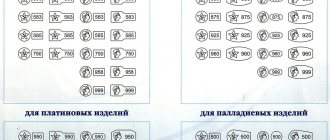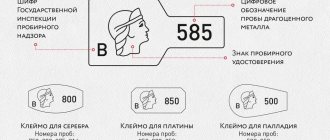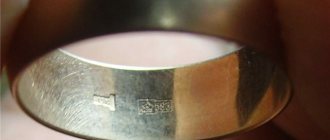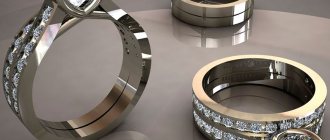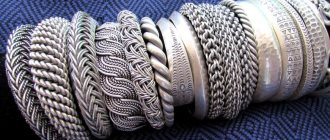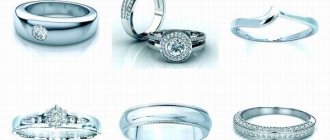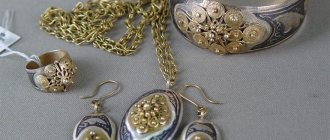Museum of Trade - Commodity Dictionary - Jewelry (Part 2)
Jewelry (Part 1)
Name tags usually had the shape of a rectangular platform on which a short alphabetic (sometimes in combination with numbers) designation of the name of the enterprise was placed with the addition to the right of the last digit of the year of manufacture of this product (1959 is conventionally designated by the number 9; 1960 by the number 0, etc. .). The number indicating the year of manufacture of the product was included in the general frame of the name sign. An exception to this rule was the name form of the “Artist” artel of the Dagestan Autonomous Soviet Socialist Republic (Kubachi village), which put on its products an icon in the form of an image of a lotus flower, in the center of which were the letters “AH” (Artel artel) and the last digit of the year of production products.
Names and letter designations of jewelry (code)
Bracelets B , BR ; Brooches BR , BS , B ; Vases B ; VL plugs ; Decanters G ; Clamps 3 ; Cufflinks ZP ; ZN icons ; KL necklace ; Rings K ; KB Cups ; KN pendants ; Spoons L ; Spatulas for cakes LP ; Medallions M ; Thimbles N ; Leaf cutter knives NL ; Knives NZh ; Necklaces O ; Ashtrays P , PP ; Cup holders PD ; Egg coasters PYA ; Cigarette cases PR ; Powder compacts PDN ; Sockets P ; RM glasses ; Sugar bowls CX ; Earrings C ; Salt shakers SL ; Stacks ST ; Chains C ; Cups H ; Teapots CHN ; Sugar tongs Shch .
The passport was accompanied by a photograph of the product and, as the main control document, was kept (one copy each) in the files of the manufacturing enterprise, the wholesale trade base - the customer and the central department, the system of which included the enterprise that produced this product. In the quality control department of the manufacturing enterprise and at the wholesale trade base (in the assortment office or in the sample room), one copy of control samples (standards) of these products was constantly stored. Labels were attached to the standards under the seal, which included: the name of the manufacturer, the name of the product, the factory code, metal, weight, date and place of approval of the sample, price and price list item. The price and article number were also included in the passport. When setting the price, the product was assigned a corresponding product article - a number under which it was entered into the price list. Due to the constant updating of the assortment and the discontinuation of products of outdated styles, with each edition of a new price list there was some movement of items. The article numbers under which discontinued products were listed in the price list were assigned to newly produced products.
The article was a four-digit number, the first two digits of which indicated a group of products, the next digits indicated the serial number of the product for each group.
The indexes for product groups are as follows: gold - bracelets 01, brooches 02, pins 03, dental products 04, cufflinks 05, rings 06, pendants and necklaces 07, medallions 08, earrings 09, cigarette cases 10, chains 11; products with garnet stones 12, filigree 13, gold leaf 14, various products 16; coral beads 15; silver products by weight 25, piece 28, bracelets 30, hat pins 31, brooches 32, cufflinks 33, rings 34, pendants and necklaces 35, medallions 36, cigarette holders 37, thimbles 38, powder boxes 40, cigarette cases 41, earrings 43, chains 44, various 45, amber products 50; jewelry metal haberdashery made of brass and tombac - bracelets 51, brooches 52, pins 53, cufflinks 55, clips 56, earrings 57, pendants 58, medallions 59, powder compacts 60, various 61; cupronickel haberdashery - bracelets 73, brooches 74, buckles 75, cufflinks 76, rings 77, necklace 78, earrings 79, combs 80; made of aluminum 81; products from cupronickel - spoons 62, forks 63, knives 64, spatulas 65, crackers, candy bowls, shot glasses 66, cigarette cases 67, products from nickel silver 70, products from tombac 71-72, cases 69.
With the introduction of a new price list, jewelry that was in the retail chain was subject to relabeling with new items indicated. Products not included in the new price list were sold at the retail prices established for them with the letter “C” (discontinued) added to the article number.
The supply of jewelry to the retail trade network took place through the following channels: enterprise - central or interregional wholesale trading base - interregional or city trading office - store; in some cases, the enterprise is a store. The supply of mass and individual gold jewelry to the republican central wholesale bases was regulated by the USSR State Planning Committee. New product samples (their first batch), mastered by enterprises and approved by all authorities, were sent to the retail chain in small parcels marked “New Products” in order to identify consumer demand for them.
The external design of jewelry stores, in particular their display windows, played an advertising and popularization role. In showcases, they are usually displayed in groups: jewelry for women, toiletries, table setting items and interior decorations, souvenirs, writing instruments, etc. Products were selected either in the same color scheme, or, conversely, a contrasting decision was made both in color and and by the texture of various materials (for example, a group of silver and enamel items looks most colorful next to crystal items, ivory items acquire a more decorative sound next to black papier-mâché boxes with picturesque paintings, etc.). New items were placed directly behind the glass in the front (facade) part of the display case. The entire area of the back glass of the display case was usually draped with theatrical tulle or other translucent fabric. To illuminate the display cases, fluorescent light sources located in the upper part, covered with milk glass or a light-diffusing grille, were used. From the street and store sides, frosted stripes were applied to the display glass in the upper part, which created a surface that scattered light. Sometimes (mainly to display transparent, for example crystal, products) a hidden light source was used, enclosed in a light-weight lamp. In order to use the entire space of the display cases at different heights and in different plans, transparent light shelves made of glass or plastic and small shields on which jewelry were placed were hung on invisible (nylon) threads; part of the space was draped with light fabrics. Enlarged photographs, silhouettes made from bent wire, artificial and fresh flowers, auxiliary tablets and mannequins were also used to decorate the display windows. Lightweight mobile equipment made it possible to frequently change the design of display cases. Typically, the design of shop windows was subordinated by the artist-decorator to a single plot concept: seasons, new items of the season, methods of using various decorations, an exhibition and sale of a particular assortment, amber jewelry, Russian gems, souvenirs and gifts, etc. For in-store decoration and retail equipment The hall used wall cabinets and cabinets in which jewelry was displayed. The most expressive displays of small women's jewelry were large shields-stands, divided into separate sections in the form of circles, rectangles and other figures, covered with single-color dress fabrics, with individual jewelry pinned on them - brooches, rings, earrings, bracelets. To facilitate the selection of goods, posters, inscriptions and annotations were used that characterize certain jewelry items.
Sales of jewelry were usually concentrated in the sections: weighted silver, haberdashery and gold items. Weighted silver, just like gold items, was sold by weight, at prices set per 1 g, depending on one or another artistic treatment. For this purpose, the store had special technical scales of the 1st accuracy class. Haberdashery was sold individually. Some valuable jewelry was sold in cases, which were usually boxes of various shapes with a special slot for the corresponding item, covered on the outside with leather or its substitutes, and lined with silk or velvet on the inside. For cheaper products, cases were used, covered with lederin, with silk, semi-velvet or satin upholstery inside. Even cheaper products were sold in plastic bags or cardboard boxes covered with glossy or matte colored paper.
Rosyuvelirtorg had a special “Sample Room”, where specialists associated with jewelry art, production and trade had the opportunity to get acquainted with modern jewelry of domestic and foreign production.
State hallmark
A heart in Stas Mikhailov’s repertoire is made of pure gold (and then only as a metaphor), but not a precious coin or a piece of jewelry. Gold and silver items are durable and strong only because they are made from alloys. True, the share of silver or gold in them often exceeds 95%. The content of precious metal in products is called breakdown. It is designated by a three-digit number, since it expresses the mass in 1000 parts of the alloy. Control over the sample is the prerogative of the state. All jewelry sold or sold in Russia - whether domestically produced or imported - is marked with an hallmark. Marking is not placed on:
- coins that have been issued;
- nuggets used in “jewelry”;
- state awards;
- gold and silver leaf;
- small cuts with precious metal on boxes, vases and other valuable items.
In Russia, a certain list of jewelry samples is valid:
- 375, 500, 583, 750 and 958 – for gold;
- 750, 800, 875, 916, 925 and 960 – silver;
- 950 – platinum;
- 500 and 850 – palladium.
The metal content must correspond to the regulated values; its share in the product cannot be less than the applied sample. In an imported product it may be slightly larger. Testing and marking are carried out by state testing inspections.
Testing systems
The most popular are metric and carat. I will talk about them and other existing sample measurement systems below. Their correspondence table looks like this:
| Metric | Carat | Zolotnikovaya | Lotovaya |
| 375 | 9 | 36 | 6 |
| 500 | 12 | 48 | 8 |
| 583, 585 | 14 | 56 | 9 |
| 750 | 18 | 72 | 12 |
| 1000 | 24 | 96 | 16 |
Carat
Used in the USA and European countries. The karat designation shows how many parts of pure gold are in 24 parts of the alloy. To convert a metric value to a carat value, you need to multiply it by 0.024.
Metric
The most popular system. Used in most countries of the world, including Russia since 1927. Shows how much gold is contained in 1000 units of the alloy.
Zolotnikovaya
Branding using the spool system was used in the Russian Empire, then in the Soviet Union until 1927. It is not currently used. The measurement was based on a pound consisting of 96 spools. Accordingly, the spool test shows how many units of gold contain 96 units of the alloy.
Lotovaya
This testing system is also from the past. It was used in the Middle Ages by Western European peoples - Celts, Germans, Scandinavians. Previously, the mass of the precious metal was calculated in marks, consisting of 16 lots. This test shows how many lots of gold are in one brand of alloy.
Deciphering the hallmark
The hallmark consists of two designations, which can be located either side by side or separately:
- the identification mark of our state is either a Soviet hammer and sickle in front and a star with five points in the background, which are still relevant as an assay mark, or a profile of a woman in a kokoshnik, turned to the right;
- sample sign.
Hallmark:
1 — Code of the State Assay Supervision Inspectorate 2 — Mark of the Assay Certificate 3 — Digital designation of the precious metal sample
Sketches of hallmarks on gold:
Sketches of an assay clamp for silver:
Most popular samples
Most jewelry is marked with the following hallmarks: 375, 500, 585, 750. 375 gold is considered low-grade. This product usually has a yellow or reddish tint and fades over time.
The middle group (500 and 585 samples) is the most popular. This ratio of precious metal and alloy in the alloy makes the item durable and durable without losing its external shine.
Jewelry of 750 standard is considered high quality. The alloy has a bright yellow color. Even in white gold, the golden yellow is clearly visible. The 750 alloy alloy usually contains other precious impurities - silver, palladium, platinum.
958 gold is rare. Such jewelry is soft and easy to deform. For minting coins, 900 standard is usually used.
What does the birthday boy look like today?
It is legally established that the name for Russian jewelry products consists of four letters, and:
– the first letter indicates the year of manufacture of the product (A – 2000, B – 2001, etc.);
– the second letter is the code of the territorial state inspectorate that controls jewelry production;
– the third and fourth letters are the code assigned to the manufacturer upon registration, which cannot be repeated within the coverage area of one inspection.
All letters that make up the name plate must be enclosed in a single outline, the shape of which is independently approved by the regional inspectorate. The letters of the name should be clear and easy to read. Any name specialist will determine where, by whom and in what year the jewelry was released.
What is a name tag?
In jewelry, a name mark is a mark that is placed on a product by its manufacturer - a factory or workshop.
By carefully studying the nameplate, you will find out who made your ring or earrings and in what region, as well as in what year it happened. Name tags are mandatory on products and serve as additional visual confirmation of the quality of the item. If there is no name on the jewelry, most likely it was made in an illegal factory or in a homemade way, and no one is responsible for its quality. However, it is not difficult to fake the name of a well-known company so that an ordinary consumer cannot distinguish it from a real brand, although a professional will instantly detect a fake.
The tradition of branding precious jewelry has deep roots in the past. Skilled craftsmen invented their own badges to mark products and at the same time certify the authenticity of the gold from which they were made. With the development of state power, supervision over the activities of jewelers is tightened and marks are unified. In Russia, state stamps appeared in the 17th century, in European countries - several centuries earlier.
Location and appearance
Where jewelry is marked depends on the type of jewelry. But regardless of the location of the sign, manufacturers try to make it inconspicuous. To find it, it is better to use a lens. Most often the mark is located in the following places:
- On a ring - inside or outside the rim.
- On earrings - on earrings or pins.
- On pendants or pendants - on special rings for hanging.
- On the bracelet - between the product and the lock.
The mark that is issued by the controlling body - the state assay office - consists of 2 contours of a rectangular, oval or oblong shape (for gold). Inside you can see the profile of a girl in a kokoshnik facing to the right, the inspection code and numbers indicating the sample. If we are talking about items made in the USSR, the gold hallmark looks like a five-pointed star.
For other precious metals, signs in the form of other figures are provided. The code shows which territorial inspection carried out the inspection and stamped the jewelry. For each division there is a strict arrangement of elements. For example, the Central Inspectorate (CIPN) marks gold products with the letter M in the lower left corner of the hallmark or a dot in its upper right corner.
How to decipher the name code on jewelry
Initially, the name stamp was intended as a kind of code about the enterprise that produced the jewelry. Such a sign made it possible to determine without unnecessary procedures which factory produced each specific piece of jewelry. The appearance of a name on precious alloys made it possible to increase the quality control of manufactured embellishments several times at the state level.
To understand what the four-digit code next to the stamp means, you need to know what information is contained in each symbol. From left to right:
- Year of issue. Denoted by one Cyrillic letter from the beginning of the alphabet. Each letter is assigned its own year. So, for example, a piece of jewelry made in 2001 is A, 2002 is B, 2003 is C, and so on.
- Code of the State Assay Supervision Inspectorate. The second sign is determined by one of 16 letters, under which the territorial inspection is encrypted, which issued a permit to operate a specific plant or enterprise.
- Manufacturer code. Any person and enterprise involved in the production of jewelry is assigned its own unique code, which is part of the name. This two-digit cipher can consist of both numbers and letters, as well as their combinations.
In addition to the authenticity of the materials used to make jewelry, the assay service has specific requirements for the appearance of the name tag, which must have clear dimensions - 0.5 x 1.5 mm. Deviation from these standards may be a significant reason to refuse registration to the manufacturer.
Question No. 3. “How many samples can there be on a piece of jewelry?”
If you come across a piece of jewelry that has less than 4 marks on it, it’s either a fake or you should look for better marks. According to international law, all jewelry made of gold , silver , platinum and palladium , as well as any alloys with them, which contain more than 30% of the precious metal, must have at least four hallmarks.
The first (geometric) designates the type of metal (rectangular hallmark for gold, rectangular hallmark with rounded sides for silver, octagonal hallmark for platinum and elongated hallmark with a rounded front for palladium).
The second mark on jewelry is a decoding of the quality of the metal, that is, the percentage of pure material contained in it. The third mark indicates in which country the jewelry was produced or sold. Usually this is a mark in the form of the country’s coat of arms or a special symbol (in Russia - a woman’s head in a kokoshnik). The fourth mark indicates in which region the composition of the metal was checked and the sample was taken.
Advantages and disadvantages of 750 gold
The 750th gold standard is not as popular among buyers as the 585th, but it is also in demand. It contains a higher proportion of pure gold, which significantly increases the cost of the alloy, and at the same time the final product. Such jewelry is considered more elite, although it has a number of significant disadvantages, including:
- low strength due to the softness of the alloy;
- low resistance to mechanical damage;
- higher price.
How to distinguish real gold from fake
Buying jewelry is not only a pleasant thing, but also a responsible one. Authenticity of a far from cheap purchase is the main task facing every buyer
It is not always possible to contact a jeweler for advice, so it would be a good idea to arm yourself with some expert advice.
Trust but check
One of the programs on Channel One said that 50%, if not more, of all gold sold in the country is fake. Even if a product is stamped, this is not a guarantee of its authenticity. I had to turn to a jeweler I knew for clarification:
— If even the most popular jewelry store offers a gold product at a price of less than 1.5 thousand rubles per gram as part of a discount promotion or not, it is most likely a fake. No matter what, you should definitely watch the sample. To do this, you can prudently take a magnifying glass with you.
A real 585 gold hallmark looks like this: a spatula-shaped imprint is pressed into the metal, inside there is the face of a girl in a kokoshnik, who is looking to the right directly at the numbers 585, as well as a letter that designates the inspector who hallmarked the product. If the stamp depicts not a girl, but a hammer and sickle, then the product is made in Soviet times.
In those days, by the way, there were practically no fakes. In the store you can check the product for teeth, if the seller allows it. Gold is a soft metal and can be easily bitten and may even leave small teeth marks.
585 purity means that the material contains 58.5% pure gold. The lowest standard in our country is 375. Oddly enough, the number 375 can often be found on jewelry made in Germany and England. Sometimes you can find jewelry made of gold of the 957th and 999th standard; they are the most expensive.
Here are some more simple tips shared by a professional:
— Buy gold exclusively in stores. You can ask the seller for a certificate for the selected product to ensure its authenticity.
— It’s good if, in addition to the sample, the product also bears the imprint of the manufacturer. This is a guarantee of high quality and responsibility for the product.
— If you throw a ring edge-on on a tiled floor, it will bounce, other metal will not.
— If you look at a gold item in sunlight and in the shade, it will be the same color in both cases.


